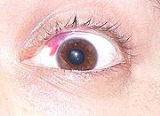
LASIK
Overview
Refractive surgery
Refractive eye surgery is any eye surgery used to improve the refractive state of the eye and decrease or eliminate dependency on glasses or contact lenses. This can include various methods of surgical remodeling of the cornea or cataract surgery. The most common methods today use excimer lasers to...
for correcting myopia
Myopia
Myopia , "shortsightedness" ) is a refractive defect of the eye in which collimated light produces image focus in front of the retina under conditions of accommodation. In simpler terms, myopia is a condition of the eye where the light that comes in does not directly focus on the retina but in...
, hyperopia
Hyperopia
Hyperopia, also known as farsightedness, longsightedness or hypermetropia, is a defect of vision caused by an imperfection in the eye , causing difficulty focusing on near objects, and in extreme cases causing a sufferer to be unable to focus on objects at any distance...
, and astigmatism
Astigmatism (eye)
Astigmatism is an optical defect in which vision is blurred due to the inability of the optics of the eye to focus a point object into a sharp focused image on the retina. This may be due to an irregular or toric curvature of the cornea or lens. There are two types of astigmatism: regular and...
. LASIK is performed by ophthalmologists using a laser
Laser
A laser is a device that emits light through a process of optical amplification based on the stimulated emission of photons. The term "laser" originated as an acronym for Light Amplification by Stimulated Emission of Radiation...
.
LASIK is similar to other surgical corrective procedures such as photorefractive keratectomy
Photorefractive keratectomy
Photorefractive keratectomy and Laser-Assisted Sub-Epithelial Keratectomy are laser eye surgery procedures intended to correct a person's vision, reducing dependency on glasses or contact lenses. The first PRK procedure was performed in 1987 by Dr. Theo Seiler, then at the Free University...
, PRK, (also called ASA, Advanced Surface Ablation) though it provides benefits such as faster patient recovery. Both LASIK and PRK represent advances over radial keratotomy
Radial keratotomy
Radial keratotomy is a refractive surgical procedure to correct myopia.- Discovery :The procedure was discovered by Svyatoslav Fyodorov who removed glass from the eye of one of his patients who had been in an accident. A boy, who wore eyeglasses, fell off his bicycle and his glasses shattered on...
in the surgical treatment of vision problems, and are thus viable alternatives to wearing corrective eyeglasses or contact lenses for many patients.
The LASIK technique was first made possible by the Colombia
Colombia
Colombia, officially the Republic of Colombia , is a unitary constitutional republic comprising thirty-two departments. The country is located in northwestern South America, bordered to the east by Venezuela and Brazil; to the south by Ecuador and Peru; to the north by the Caribbean Sea; to the...
-based Spanish
Spain
Spain , officially the Kingdom of Spain languages]] under the European Charter for Regional or Minority Languages. In each of these, Spain's official name is as follows:;;;;;;), is a country and member state of the European Union located in southwestern Europe on the Iberian Peninsula...
ophthalmologist Jose Barraquer
Jose Barraquer
José Ignacio Barraquer Moner was an ophthalmologist known to many as "the father of modern refractive surgery"...
, who, around 1950 in his clinic in Bogotá
Bogotá
Bogotá, Distrito Capital , from 1991 to 2000 called Santa Fé de Bogotá, is the capital, and largest city, of Colombia. It is also designated by the national constitution as the capital of the department of Cundinamarca, even though the city of Bogotá now comprises an independent Capital district...
, Colombia, developed the first microkeratome
Microkeratome
A microkeratome is a precision surgical instrument with an oscillating blade designed for creating the corneal flap in LASIK or ALK surgery. The normal human cornea varies from around 500 to 600 micrometres in thickness; and in the LASIK procedure, the microkeratome creates a 83 to 200 micrometre...
, and developed the technique used to cut thin flaps in the cornea
Cornea
The cornea is the transparent front part of the eye that covers the iris, pupil, and anterior chamber. Together with the lens, the cornea refracts light, with the cornea accounting for approximately two-thirds of the eye's total optical power. In humans, the refractive power of the cornea is...
and alter its shape, in a procedure he called keratomileusis
Keratomileusis
Keratomileusis is the surgical improvement of the refractive state of the cornea performed by lifting up the front surface of the eye by forming a thin hinged flap under which the shape of the cornea is changed by using an excimer laser or other surgical device, and was developed by José Ignacio...
.
Discussions

